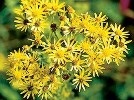August 26, 2010

Farmers in western Oregon his summer are noticing patches of telltale bright yellow flowers of tansy ragwort, a noxious weed once the scourge of the 1970s.
But experts at the Oregon Department of Agriculture say it is not a cause for worry this time around since successful biological control agents should keep the plant from making an unwelcome comeback to prior levels.
As the weed grows, so do populations of flea beetles and cinnabar moths that feed on it.
In early August, ODA has received calls from landowners anxious about the return of the ragwort, currently at a very visible stage. Outbreaks are reported as spotty and localized.
But many Oregonians remember the bad old days when tansy was so invasive in the western part of the state that cattle and horse owners reported more than $4 million in losses yearly as their animals grazed on infected pastures.
Too often, leaves of tansy grew among the grasses consumed by livestock, leading to sickness and death.
At this point of the growing season, the tansy flowers are in bloom and the weed is tall enough for animals to avoid by eating around it, ODA officials believe.
"The late spring and early summer rain has led to resurgence in some areas," notes department entomologist Eric Coombs. "It's counterintuitive to just let it go right now, but the whole premise of biological control is to allow the insects present to naturally build up on their own."
He visited several sites where tansy has popped up this year and has found the "good" bugs that kill the plant present in all cases. This comes after intensive efforts years ago to release insects in infested areas where the flea beetle and cinnabar moth are now well established as part of the natural environment.
Due to the cool, wet spring, cinnabar moth populations are very low this year, but flea beetles are still active, he reports.
"I think we've done our job, now it's time to wait and let the insects do their job," says Coombs. "It's a natural cycle. We will get flare-ups of tansy ragwort that will move around from field to field depending on factors like weather, or how the field is used.
"It might be another year or two before the insects build up in numbers again and knock the weed back down. It would take three to five years if the natural enemies had to be reintroduced."
For a profile on tansy ragwort, go to oregon.gov/ODA/PLANT/WEEDS/profile_tansyragwort.shtml.
You May Also Like




